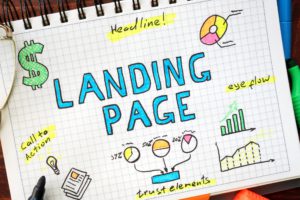
5 Types of Landing Pages To Increase Your Lead Conversion Rate
Are your company website’s landing pages converting as many visitors to leads as you’d like? If you have a low lead conversion rate, one problem may be that you are not using the right kinds of landing pages. Landing pages have several purposes: to collect important information from visitors, to begin building a relationship with visitors, and, ultimately, to convert visitors to leads. Some companies only have one or two types of landing pages, and as a result, their lead conversion rates suffer.
Before exploring types of landing pages, let’s first understand what a landing page is.
What Is a Landing Page?
A landing page is a standalone web page designed with a specific purpose in mind. The purpose is typically to convert visitors into leads or customers. Unlike a general website page, landing pages have one clear goal. There are many goals landing pages can be created to achieve, such as prompting signup for a newsletter, downloading an eBook, making a purchase, and many more.

5 Types of Landing Pages To Increase Conversion Rate
Here are 5 different types of landing pages that are sure to increase your lead conversion rate.
1. Email List Opt-In Landing Page:
It’s proven that the most effective place to put your email opt-in form is on it’s own dedicated landing page. An email list opt-in landing page gives you more room to tell visitors exactly how they stand to benefit from filling out your form with their personal information. By removing pesky distractions, like navigation, a landing page urges your visitors make a decision: opt-in or miss out on quality content and offers.
2. Product Detail Landing Page:
A product detail landing page is common in the retail industry. It serves as dedicated space on the company’s website to showcase information about a specific product. Product detail landing pages are positioned within the website’s navigation. They contain information regarding the product for sale such as features and specifications. Product detail landing pages also contain customer reviews. A benefit of product detail landing pages is that there is no extra work or cost required when it comes to creating a separate page. An additional benefit of this type of landing page is that it applies to visitors who are in the awareness or the consideration stage.
Read more on Driving Website Conversions During Each Stage Of The Buyer’s Journey
3. Coming From [social network] Landing Page:
You can apply this type of landing page to every type of traffic that your website generates. Most likely, any landing pages attached to your social media accounts bring visitors to your home page. This is a start, but it’s not the best option. You should make your landing page more customized and personal. A good social network landing page addresses where the visitor is coming from. It also provides information that the visitor is probably looking for. This can be information like background about the company. It can also be information about how to get in touch with the company, such as an email address, phone number, etc.
4. Content Guide Landing Page:
Inbound marketing revolves around the creation and distribution of content. If your company actively blogs, you have the opportunity to extend the reach of your blog content by organizing it with its own landing page. While the blog page on your website is useful, it probably only shows your most recent blog content. By creating topic-specific content landing pages, you can curate your blog content and showcase your best quality work to your site’s visitors. Topic-specific content landing pages engage your audience at different stages of their journey. Structuring your content like this optimizes user engagement. Additionally, it bolster’s your brand’s authority and relevance within your industry.

5. Lead Capture Landing Pages
Marketers often refer to lead capture landing pages as “squeeze” pages. The goal of squeeze pages is to capture leads without distractions. Lead capture landing pages don’t contain any exit paths or distractions such as links or navigation tools. This type of landing page should include one thing: a prominent call-to-action (CTA) button that takes visitors to a form where they are encouraged to submit their personal data. In order to coax visitors into filling out the form, you should offer an incentive. Incentives can be eBooks, whitepapers, or webinars. This strategy boosts lead generation and builds trust with potential customers. Additionally, it enhances engagement.
Use these five types of landing pages to increase your lead conversion rate.



